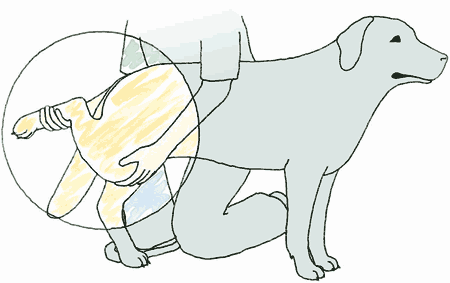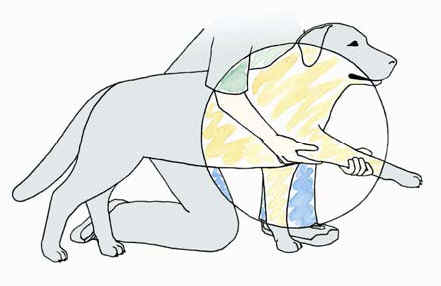Here is our first article from a guest author! Susan Sleight is the director of the Veterinary Assistant/Pre-Vet Tech Program at the Bridgerland ATC. She also owns (among other animals) a great Border Collie named Ladybug who does agility with the program. Thanks Susan for sharing this very helpful medical information with us!
We all know how important it is to keep our canine companions healthy. This includes proper diet, dental care, vaccinations, parasite preventatives, grooming, etc. I would like to address an often over looked aspect to a good wellness program. This area is the wellness blood chemistry profile. Many folks think that because their canine is not exhibiting any symptoms that there is no need to pay for a chemistry profile.
We all know how important it is to keep our canine companions healthy. This includes proper diet, dental care, vaccinations, parasite preventatives, grooming, etc. I would like to address an often over looked aspect to a good wellness program. This area is the wellness blood chemistry profile. Many folks think that because their canine is not exhibiting any symptoms that there is no need to pay for a chemistry profile.
Unfortunately, this attitude can lead to complications as an undiagnosed disease leads to a severe situation.
A typical blood chemistry panel usually includes...
General Metabolism Kidney Function
GLU (Glucose) BUN (Blood Urea Nitrogen)
LDH (Lactate dehydrogenase) CREAT (Creatinine)
CPK (Creatine phosphokinase)
LDH (Lactate dehydrogenase) CREAT (Creatinine)
CPK (Creatine phosphokinase)
Electrolytes Liver Function
Na (Sodium) ALP (Alkaline phosphatase)
K (Potassium) ALB (Albumin)
Cl (Chloride) GGT (Gamma-glutamyl transpeptidase)
CA (Calcium) PT (Serum glutamate pyruvate transaminase)
PHOS (Phosphorus) TP (Total Protein)
Cl (Chloride) GGT (Gamma-glutamyl transpeptidase)
CA (Calcium) PT (Serum glutamate pyruvate transaminase)
PHOS (Phosphorus) TP (Total Protein)
CHOL (Cholesterol)
GLOB (Globulin)
TBILI (Total Bilirubin)
Thyroid Pancreas
T3 (Triiodothyronine) AMY (Amylase)
T4 (Thyroxine) LIP (Lipase)
Here are two case histories to illustrate my point:
Case 1
Presentation:
· 3 year old male castrated Labrador Retriever
· Presented for regular physical examination and vaccinations.
· OWNER REPORTS NO ILLNESS OR ABNORMAL BEHAVIOR.
· Obesity
· Otitis Externa Right Ear
Wellness Panel:
ALP: 135 (Normal 20 – 150)
ALT:48 (Normal 10 -118)
BUN: 13 (Normal 7 – 25)
CRE :1.6 (Normal 0.3 – 1.4)
GLU: 517 (Normal 60 – 110)
Diagnosis: Diabetes Mellitus
Case 2
Presentation:
18-month-old male castrated Shetland Sheepdog presented for regular examination and vaccines.
NO PROBLEMS OR CONCERNS NOTED BY THE OWNER.
Physical Examination: No Abnormalities Noted
Wellness Testing:
ALP: 74 (Normal 20-150)
ALT: 23 (Normal 10-118)
BUN: 47 (Normal 7-25)
CRE: 2.0 (Normal 0.3-1.4)
GLU: 131 (Normal 60-110)
TP: 7.5 (Noraml 5.4-8.2)
Additional Diagnostics:
Complete Blood Count Additional Chemistries Urinalysis
WBC: 14.5 (6-17) ALB: 2.5 (2.5-4.4) Leukocytes: Neg
LYM: 3.42 (1-4.6) AMY: 1148 (200-1200) Nitrite: Neg
MON: 0.48 (0-3) TBIL: 0.9 (0.1-0.6) Urobilinogen: Neg
LY%: 23.6% (3-12) CA++: 11.4 (8.6-11.8) Protein: 300 mg/dl (3+)
MO%: 3.3 PHOS: 2.6 (2.9-6.6) pH: 6.0
GR%: 73 (62-87) NA+: 147 (138-160) Blood: Neg
PLT: 371 (200-500) K+: 3.8 (3.7-5.8) Ketone: Neg
RBC: 7.01 (5.5-8.5) GLOB: 4.5 (2.3-5.2) Bilirubin: Neg
HGB: 18.8 (12-18) Glucose: Neg
HCT: 47.2% (37-55) Sp. Gr.: 1.020
MCV: 26.8 (19.5-24.5) Microscopic
MCHC: 39.7 (31-34) 3+ Cuboidal Cells
RDWc: 15.1% 2+ Granular Casts
Protein/Creatinine Ratio: 3.8 (>1 indicates glomerular disease)
Urine Culture: No Growth
Renal Ultrasound: Consistent with renal hypoplasia with evidence of interstitial nephritis/renal fibrosis.
Diagnosis: Renal hypoplasia with interstitial nephritis/fibrosis
These two cases are an everyday example of why wellness blood chemistry testing should become a vital part of your canine health program. These two cases also illustrate how age is not a factor, both of these canines are very young!
When a problem is found early it is much easier to treat and keep your canine healthy, happy, and flying on that agility course!











